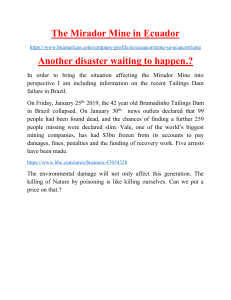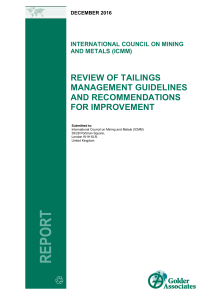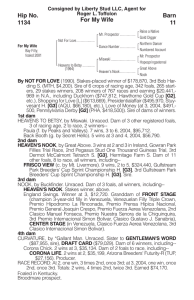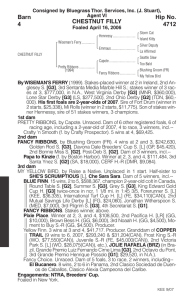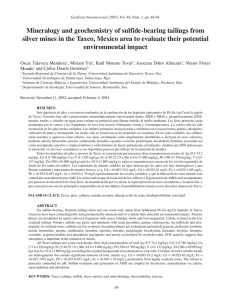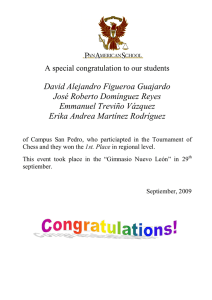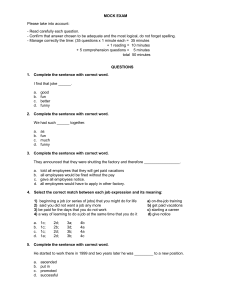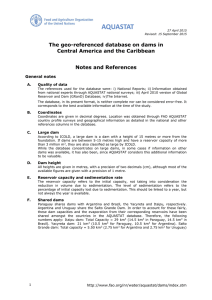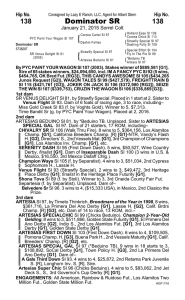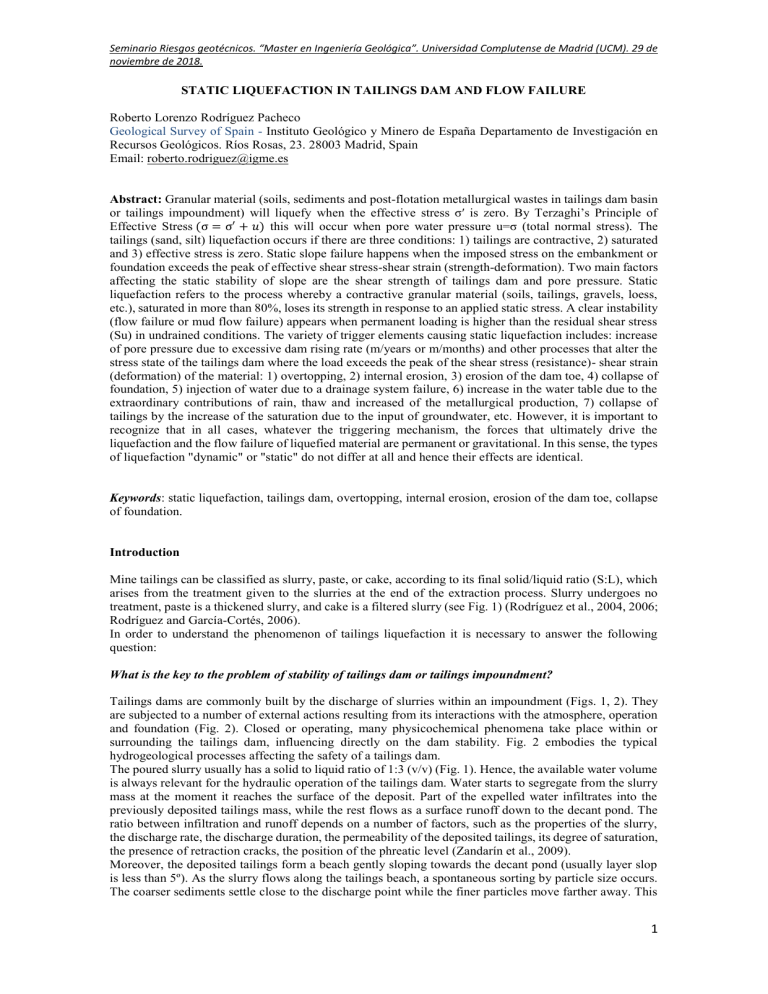
Seminario Riesgos geotécnicos. “Master en Ingeniería Geológica”. Universidad Complutense de Madrid (UCM). 29 de noviembre de 2018. STATIC LIQUEFACTION IN TAILINGS DAM AND FLOW FAILURE Roberto Lorenzo Rodríguez Pacheco Geological Survey of Spain - Instituto Geológico y Minero de España Departamento de Investigación en Recursos Geológicos. Ríos Rosas, 23. 28003 Madrid, Spain Email: [email protected] Abstract: Granular material (soils, sediments and post-flotation metallurgical wastes in tailings dam basin or tailings impoundment) will liquefy when the effective stress σ′ is zero. By Terzaghi’s Principle of Effective Stress (σ = σ′ + 𝑢) this will occur when pore water pressure u=σ (total normal stress). The tailings (sand, silt) liquefaction occurs if there are three conditions: 1) tailings are contractive, 2) saturated and 3) effective stress is zero. Static slope failure happens when the imposed stress on the embankment or foundation exceeds the peak of effective shear stress-shear strain (strength-deformation). Two main factors affecting the static stability of slope are the shear strength of tailings dam and pore pressure. Static liquefaction refers to the process whereby a contractive granular material (soils, tailings, gravels, loess, etc.), saturated in more than 80%, loses its strength in response to an applied static stress. A clear instability (flow failure or mud flow failure) appears when permanent loading is higher than the residual shear stress (Su) in undrained conditions. The variety of trigger elements causing static liquefaction includes: increase of pore pressure due to excessive dam rising rate (m/years or m/months) and other processes that alter the stress state of the tailings dam where the load exceeds the peak of the shear stress (resistance)- shear strain (deformation) of the material: 1) overtopping, 2) internal erosion, 3) erosion of the dam toe, 4) collapse of foundation, 5) injection of water due to a drainage system failure, 6) increase in the water table due to the extraordinary contributions of rain, thaw and increased of the metallurgical production, 7) collapse of tailings by the increase of the saturation due to the input of groundwater, etc. However, it is important to recognize that in all cases, whatever the triggering mechanism, the forces that ultimately drive the liquefaction and the flow failure of liquefied material are permanent or gravitational. In this sense, the types of liquefaction "dynamic" or "static" do not differ at all and hence their effects are identical. Keywords: static liquefaction, tailings dam, overtopping, internal erosion, erosion of the dam toe, collapse of foundation. Introduction Mine tailings can be classified as slurry, paste, or cake, according to its final solid/liquid ratio (S:L), which arises from the treatment given to the slurries at the end of the extraction process. Slurry undergoes no treatment, paste is a thickened slurry, and cake is a filtered slurry (see Fig. 1) (Rodríguez et al., 2004, 2006; Rodríguez and García-Cortés, 2006). In order to understand the phenomenon of tailings liquefaction it is necessary to answer the following question: What is the key to the problem of stability of tailings dam or tailings impoundment? Tailings dams are commonly built by the discharge of slurries within an impoundment (Figs. 1, 2). They are subjected to a number of external actions resulting from its interactions with the atmosphere, operation and foundation (Fig. 2). Closed or operating, many physicochemical phenomena take place within or surrounding the tailings dam, influencing directly on the dam stability. Fig. 2 embodies the typical hydrogeological processes affecting the safety of a tailings dam. The poured slurry usually has a solid to liquid ratio of 1:3 (v/v) (Fig. 1). Hence, the available water volume is always relevant for the hydraulic operation of the tailings dam. Water starts to segregate from the slurry mass at the moment it reaches the surface of the deposit. Part of the expelled water infiltrates into the previously deposited tailings mass, while the rest flows as a surface runoff down to the decant pond. The ratio between infiltration and runoff depends on a number of factors, such as the properties of the slurry, the discharge rate, the discharge duration, the permeability of the deposited tailings, its degree of saturation, the presence of retraction cracks, the position of the phreatic level (Zandarín et al., 2009). Moreover, the deposited tailings form a beach gently sloping towards the decant pond (usually layer slop is less than 5º). As the slurry flows along the tailings beach, a spontaneous sorting by particle size occurs. The coarser sediments settle close to the discharge point while the finer particles move farther away. This 1 Seminario Riesgos geotécnicos. “Master en Ingeniería Geológica”. Universidad Complutense de Madrid (UCM). 29 de noviembre de 2018. is a favourable effect, since it produces a material with higher hydraulic conductivity near the dam wall, helping to depress the phreatic surface there, and hence improving the stability conditions of the deposit. Fig. 1. a) Types of mine tailings according to its solid/liquid ratio, including profiles for gravimetric water content, saturation degree, and water volume fraction and b) comparison between w/w and v/v ratios for a particle density of 3 g/cm3. (modified from Garino et al., 2012 and Caparrós, 2017). Fig. 2. Scheme of the factors and phenomena that affect the operation of a tailings dam (modified from Zandarín et al., 2009). During rainfall, additional amounts of water enter the deposit. Part of it infiltrates and the rest will flow as surface runoff, finally reaching the decant pond. Evaporation also occurs on the tailings surface. Usually, the position of discharge points is regularly changed, so as to manage the levels of the tailings within the deposit and to control the position of the decant pond. Evaporation rate induces an ascending flow by capillary rise, fed from the phreatic surface. Drying rate of a porous material is a complex phenomenon, controlled by multiple factors, such as relative humidity of air, wind speed, available heat (mainly sun radiation), properties of the material controlling capillary rise, vapour diffusion in the porous media… If drying goes on during enough time, retraction cracking may occur in the surface of tailings. Vertical cracks 2 Seminario Riesgos geotécnicos. “Master en Ingeniería Geológica”. Universidad Complutense de Madrid (UCM). 29 de noviembre de 2018. together with horizontal (or subhorizontal) layering dramatically change the hydraulic conductivity of the material (Rodríguez, 2002, 2006). Liquefaction of tailings Granular material (soils, sediments and post-flotation metallurgical wastes in tailings dam basin or tailings impoundment) will liquefy when the effective stress σ′ is zero. By Terzaghi’s Principle of Effective Stress (Equation 1) this will occur when pore water pressure u=σ (total normal stress). σ = σ′ + 𝑢 (1) σ′ = σ − 𝑢 (2) The Principle of Effective Stress applies only to fully saturated soils, and relates the following three stresses: 1) the total normal stress σ on a plane within the soil mass is the force per unit area transmitted in a normal direction across the plane, taking the soil as a solid material, 2) the pore water pressure u is the pressure of the water filling the void space between the solid particles and 3) the effective normal stress σ′ on the plane represents the stress transmitted through the soil skeleton only (i.e. due to interparticle forces). Based on this Principle, shear stress resistance of the soils (sediments, tailings or post flotation metallurgical waste, anthropogenic soils, etc.) takes the following expression (Equation 3): τ = (σ − u) ∗ tagφ + 𝑐 when c=0 then τ = (σ − u) ∗ tagφ (3) where τ is the shear stress, σ is the normal stress on the sliding plane, u is the pore water pressure, φ is the internal friction angle, and c is the cohesion. The last two variables (φ and c) are shear stress interparticle components characteristics of the tailings materials. The internal friction angle ranges 18–38º for tailings (Rodríguez, 2002, 2006). The cohesion is cero for tailings, sand, gravel, etc. According to Equation (3), when the pore water pressure increases, the shear stress resistance of the material decreases and at some point, the geotechnical stability of the tailings dam is lost (FS is less than one, Fig. 3). The pore pressure rises due to a dynamic action (seismic event, transit of machinery, blasting) and a static load (excessive dam rising rate, injection of water due to the failure of the drainage system, increase of recharge, etc.) (Oldecop and Rodríguez, 2006). The effect of increasing the water pore pressure in a material is, from a geotechnical point of view, truly devastating since tailings are released into the environment. If the liquefied material is temporarily transformed into a heavy liquid, much denser than water, (because the density of the solid particles of the tailings is greater than 2.76 g/cm3) the increase in pore pressure also produces a "softening" of the soil (Rodríguez, 2006). Other effects of the increase of pore pressure is the appearance of pressure gradients of water and therefore of the water flows that try to escape to areas of lower pressure. These flows can be the cause of the formation of cracks in the surface, material drag, redistribution of voids (effect of sheet of water or water film). Fig. 3 depicts the failure mechanism developed due to an excessive loading rate. Using a mechanical simile, a potential sliding plane supports a weight W by means of the force N′ transmitted through the tailings skeleton (the spring in the drawing) and the water pore pressure u (dashpot). Shear strength of the material R is proportional to N′ by the friction (N′ tag φ). As seepage occurs, the material consolidates, reduces its volume, and the material recovers its shear strength. When the loading rate increases too fast, the water pore pressure cannot dissipate timely (sediment under undrained conditions) and the shear strength of the soil drops, causing the slope unstable. When water fills up the void spaces of granular material (tailings, sand, silt), volume changes involve transient flow of pore water—outflow in contractive conditions (pore volume reduction) or inflow in 3 Seminario Riesgos geotécnicos. “Master en Ingeniería Geológica”. Universidad Complutense de Madrid (UCM). 29 de noviembre de 2018. dilatant conditions (increase in pore volume). Water transfer mechanism takes more or less time, depending on the permeability of the material. If permeability is low (in tailings is low), the distance to the freedraining boundary of the layer is high when (or if) loading process happens quickly, then stress changes occur under undrained conditions. As the pore water cannot drain, its pressure will increase under contractive conditions (tailings are contractive), or the other way around. As stated in the Principle of Effective Stress, sudden changes in the pore water pressure will dramatically affect the shear stress resistance of the tailings. Fig. 3. Flow failure due to the raise of the pore water pressure u. W material weight over the slip surface, T shear component of weight, N normal component of weight, N′ effective normal force exerted from the slip surface, R shear strength of the soil along the failure plane, F factor of safety, A is area and angle of the dam slope is i (modified from Oldecop and Rodríguez, 2006, Oldecop et al., 2008; Oldecop and Rodríguez, 2018). Static liquefaction and flow failure Static slope failure happens when the imposed stress on the embankment or foundation exceeds the peak of effective shear stress-shear strain (strength-deformation) (Figs. 3, 4). Two main factors affecting the static stability of slope are the shear strength of tailings dam and pore pressure. Static liquefaction refers to the process whereby a contractive granular material (soils, tailings, gravels, loess, etc.), saturated in more than 80%, loses its strength in response to an applied static stress. A clear instability (flow failure or mud flow failure) appears when permanent loading is higher than the residual shear stress S u in undrained conditions (Fig. 3, 4). The variety of trigger elements causing static liquefaction includes: increase of pore pressure due to excessive dam rising rate (m/years) and other processes that alter the stress state of the tailings dam where the load exceeds the peak of the shear stress (resistance)- shear strain (deformation) of the material: 1) Overtopping, 2) Internal erosion, 3) Erosion of the dam toe, 4) Collapse of foundation, 5) Injection of water due to a drainage system failure, 6) Increase in the water table due to the extraordinary contributions of rain, thaw and increased of the metallurgical production, 7) Collapse of tailings by the increase of the saturation due to the input of groundwater, etc. However, it is important to recognize that in all cases, whatever the triggering mechanism, the forces that ultimately drive the liquefaction and the flow failure of liquefied material are permanent or gravitational. In this sense, the types of liquefaction "dynamic" or "static" do not differ at all and hence their effects are identical. 4 Seminario Riesgos geotécnicos. “Master en Ingeniería Geológica”. Universidad Complutense de Madrid (UCM). 29 de noviembre de 2018. Fig. 4. Geotechnical response of sediment in tailings dam basins under undrained conditions. Illustration of the cyclical mobility and liquefaction cases, where (a) material under dilatant conditions, (b) material under contractive conditions and τ0 < Su, and (c) material under contractive conditions and τ0 > Su. τ shear-stress resistance of the material; γ shear strain; τ0 initial shear-stress resistance of the material, due to permanent—gravitational—loadings; Su residual shear stress (modified from Oldecop and Rodríguez, 2006) and d) stress-strain response of a saturated, contractive sandy soil, under static and cyclic loading. The left plot refers to shear loading and the right plot to normal loading (adapted from Olson and Stark, 2003). Su(yield) yield shear strength, Su(LIQ) liquefied shear strength. Internal erosion by piping Figs. 5a and 6a illustrates the internal erosion by piping. Internal erosion refers to the soil fine particle movement by water flow within sediments (tailings). It can take place in an embankment, foundation, or contact area between embankment and foundation. In any case, hydraulic gradient and specific material susceptibility—such as plasticity and particle gradation—play a critical role. The initiation of this process starts when the material is susceptible to it and the onset of critical stress and hydraulic load are achieved. Material susceptibility is the relative erosion resistance and dispersiveness of a soil. The critical hydraulic load is related to the hydraulic energy required to invoke a mechanism of internal erosion, by means of seepage flow through the tailings dam or foundation. The critical stress condition is related to the ability to resist the effective stress, providing its spatial and temporal variability within the body of the dam. After the internal erosion initiates, it can progress by forming a roof and concentrated leak, which can lead to a breaching of the tailings dam. In the case of tailings dams due to water regrowth, this process may be favoured by the preferential flow through contacts between continuous dams. Horizontal flow may exist due to the existence of confined water layer or horizons. The process of internal erosion is favoured by the acid mine drainage (AMD) and 5 Seminario Riesgos geotécnicos. “Master en Ingeniería Geológica”. Universidad Complutense de Madrid (UCM). 29 de noviembre de 2018. the recirculation of water that is a common practice in mining industry. The recirculated waters have greater dissolution capacity. Fig 5. The sketch shows different mechanisms or processes that cause static liquefaction a) Tailings dam failure by internal erosion (piping), b) tailings dam failure by overtopping, water overflow causes the erosion of the outer face, c) tailings dam failure by hydric erosion of the toe. In all shown cases, the shear stresses increase on the tailings till reaching the instability and static liquefaction may occur (τ is the shear stress and γ is the shear strain or deformation (modified from Oldecop and Rodríguez, 2006, Caparrós, 2017, Oldecop and Rodríguez, 2018), and d) the three zones where the dam can fail. Hydric erosion of the dam toe Some tailings dams are located at valley sites or close to watercourses—permanent or ephemeral. In those cases, the hydric erosion of the dam toe can progressively aggravate dam instability, as shown in Fig. 5b. In most flow failure cases due to static liquefaction, the tailings dams are in these conditions. Overtopping and crest erosion Crest erosion, crest subsidence, poor management of the lagoon, or major climatic events can suddenly increase the water level until exceeding the dam crest. Overtopping normally results from design error or waves due to strong wind or earth/rock slide into the reservoir (tailings basin). In general, sustained overtopping results in a more catastrophic failure (Figs. 5c, 6b). Sustained overtopping can occur due to water level increase in the tailings dam lagoon, while wave overtopping appears when a wave washes over the crest (Fig. 5c, 6b). The shear strength of tailings increases as the density of the tailings rises. Higher density can be achieved by natural evaporation or consolidation, for instance. The location of the phreatic surface in a tailings dam is also an important factor to consider in the static slope instability, because pore pressure increases as phreatic surface rises. Body, toe or foundation are the three main zones where the TDBs can fail, as shown in Fig. 2d. Influence of the water table (the phreatic surface) on geotechnical stability Fig. 6 shows the effect of the water table on the safety factor. The phreatic surface is critical for the dam stability. Dam failure can occur, if the beach width between the decant pond (lagoon) and the dam crest (free boar) becomes too small - from flood inflow, or from improper mill operation, for example, in this case the hydraulic gradient is very high. While the determination of phreatic surface location is so important for upstream-type embankments, it is more complex by far for this embankment type than for any other 6 Seminario Riesgos geotécnicos. “Master en Ingeniería Geológica”. Universidad Complutense de Madrid (UCM). 29 de noviembre de 2018. type of tailings-retention structure. For example, Fig. 6 show a tailings dam stability analysis with a defined constant slip surface depth (Z). In the analysis of the FS the depth of the phreatic surface is varied, with the water table at a depth (1-m) Z, the FS decreases as the water table rises. The slip condition (FS = 1) is reached when m = 0.6. Fig. 6. The sketch shows different mechanisms or processes that cause static liquefaction. a) dam failure from piping, b) dam failure from overtopping, c) dam failure from water level rise, d) Dam failure from excessive dam rising rate (modified from http://www.wise-uranium.org/mdas.html). Fig. 6. Influence of the water table on stability. FS is safety factor, Z is depth, V and H are vertical and horizontal scale respectively, (modified from Oldecop et al., 2008, Oldecop and Rodríguez, 2018). Fig. 7 shows the influence of the water table on the safety factor in the case of static liquefaction of the Stava tailings dam failure in 1985, Italy. Chandler and Tosatti (1995) analysed the stability of the slope of the upper tailings dam 2. For four hypothetical water table positions, shown in Fig. 7, the safety factors obtained for the sliding surface shown are: 1.35, 1.21, 1.04 and 0.76 (surfaces A, B, C and D respectively). Considering that this dam did not have specific provisions to facilitate drainage of water, it is easy to think 7 Seminario Riesgos geotécnicos. “Master en Ingeniería Geológica”. Universidad Complutense de Madrid (UCM). 29 de noviembre de 2018. that the most likely failure mechanism for static liquefaction was the approximation of the water table to the slope. At the time of the static liquefaction and flow failure, the decantation pond was very close to the crest of the dam and the free board was less than 4 meters. Fig. 7. Influence of the water table on the safety factor in the case of static liquefaction and flow failure of the Stava tailings dam failure on July 19, 1985, Italy (modified from Chandler and Tosatti, 1995). To illustrate the strong influence that the proximity of the water table has on the stability of a slope, the Fig. 8 analyses the ideal case of a slope of a granular material (without cohesion) of infinite extension. With no flow water presence, for the adopted slope and the friction angle assumed for the material, the slope has a slip safety factor of 1.5, a value that can be considered adequate for a tailings dam project. If the water table approaches the slope, the safety factor decreases drastically due to the joint action of the flotation force and the filtering forces. In the limit case in which the water table coincides with the surface of the slope (flow parallel to the slope), the safety factor would decrease to 0.75. Finally, in the case of a horizontal flow, with the water outcropping on the slope, the safety factor decreases to 0.56. Fig. 8. Analyses of the effect of water flow on safety factor (FS) for a slope of a granular material (without cohesion) of infinite extension, a) unsaturated conditions (no flow water presence), b) water flow parallel to the slope and c) water flow perpendicular to the slope (adapted from Oldecop and Rodríguez, 2006, oldecop et al., 2008; Oldecop and Rodríguez, 2018). Kealy and Busch, (1971) determined seepage characteristics of Mill-tailings dam by the Finite-Element Method and the effect of the surface water on the stability of the slope (Fig. 9). 8 Seminario Riesgos geotécnicos. “Master en Ingeniería Geológica”. Universidad Complutense de Madrid (UCM). 29 de noviembre de 2018. Fig. 9. Variation of the safety factor stability respect to the height of the piezometric level in the tailings dam (modified from Kealy and Busch, 1971). How static liquefaction is identified in tailings dams? Different water escape structures form during the fluidization and liquefaction of tailings. These structures represent both the direct rearrangement of sediment grains by escaping fluids and the deformation of hydroplastic, liquefied, or fluidized soft-sediment in response to external stresses (static load). Water escape structures most commonly form in fine‐ to medium‐grained sands tailings deposited at high instantaneous and mean sedimentation rates. Fig. 10 shows two types of these structures: sand volcanoes and sand dikes. Fig. 10. The figure shows the static liquefaction in three tailings dams, a) sand volcanoes, b) sand dikes in surface tailings basin and c) sand dikes in profile. When the flow failure of a tailings dam occurs, different structures are associated with them: tensile cracks, piping, sinkhole, and tailings flow (Fig. 11). 9 Seminario Riesgos geotécnicos. “Master en Ingeniería Geológica”. Universidad Complutense de Madrid (UCM). 29 de noviembre de 2018. Fig. 11. a) Piping and b) sinkhole and tensile cracks, the scale was 2-m long and the hole was 8-m wide. How to increase the stability of a tailings dam? Due to the construction process, the physical, mechanical and hydrogeological properties of the tailings have great variability within the deposit and a complex distribution (classification due to particles segregation and change of the discharge point, stratification, cracking, paleochanel, etc., Rodríguez and Candela, 2004). Among the stabilizing effects, we can count on the increase in the shear stress due to suction and capillary forces (tailings in unsaturated conditions). Environmental consequences of flow failures and the release of tailings into the environment The tailings release to the environment have catastrophic consequences for the environment, economy, society, for the image of the mining industry and government authorities. In many cases the effects are irreversible. Upon a tailings dam liquefied and develop into a flow failure, large parts of the impounded tailings may be released in a slurry wave, causing catastrophic devastation in the downstream area. Typically, such slurry waves can travel at speeds as high as 8 - 40 km/h. The distance travelled by liquefied tailings is variable, from a few metres to 645 km. The area occupied by the slide of the tailings dam and the liquefied tailings can be from a few meters to more than one hundred square kilometres. In many cases of flow failure there are deaths of people (https://worldminetailingsfailures.org/). These accidents are the reason why society rejects mining activity. Conclusion and discussion The tailings (sand, silt) liquefaction occurs if there are three conditions: 1) tailings are contractive, 2) saturated and 3) effective stress is zero. But for the flow failure to occur, it is necessary that the shear stress exceeds the undrained residual resistance (Su, Figs. 3, 4). The only way to avoid the flow failure is that the saturation of the tailings is less than 80% (unsaturated conditions). The main deficiency of the current tailings dam monitoring systems is the incapability of detecting the capillary height, the degree of saturation and the suction of the tailings. For this reason, the loss of the margin of the safety factor can occur without any external signal on the dam. The capillary height in tailings varies between 0.6 and 20 meters for sand and silty-clay size particles respectively (Oldecop and Rodríguez, 2006). The negative effect of capillary water is that the degree of saturation remains high. Due to this, during an important strong rain the phreatic surface (PS) rises very quickly (in hours) and after the storm the SF descends slowly (days) (Zndarín et al., 2009). Capillary water can’t be drained by gravity (vacuum) and, what is more serious, it is not detected with traditional auscultation equipment! (piezometers). 10 Seminario Riesgos geotécnicos. “Master en Ingeniería Geológica”. Universidad Complutense de Madrid (UCM). 29 de noviembre de 2018. In all cases of flow failure in tailings dams the following elements were present, the dam was saturated, the drainage system was rigid or defective, the tailings were on unconsolidated materials (Fig. 2). The EU recommends for upstream tailings dams raising rate restrictions less than 5 m/years (this is equals to 14 mm/day), to avoid insufficient consolidation and pore pressure build-up (EU, 2009). The key is water balance and tailings dam-water cycle. Why? Input = Output ± Storege coefficient (4) The water Output has to be always bigger than the Input to guarantee that the tailings are in unsaturated conditions, fundamentally in the area near the dam (beach, Figs. 2). The hydraulic operation of the tailings dam is decisive for its stability during operation and after tailings dam closure. Infiltration and evapotranspiration are the two key parameters. Fundamental controls on tailings consolidation and water Output are exerted by the bulk tailings properties of grain size, packing, stratification, permeability, desiccation cracks and strength, which together determine whether consolidation will occur and, if so the course it follows, and by external disturbances which act to trigger liquefaction and fluidization. The liquefaction and fluidization of tailings (sand, silt, silty-clay) usually accompanies the collapse of loosely packed cross‐bedded deposits (stratification in tailings dam basin due to change in point of discharge). This collapse is commonly initiated by water forced into the units as underlying beds, especially sands and silt, consolidate. The consolidation of subjacent units is often triggered by the rapid deposition of the tailings itself, although earthquakes or other disturbances are probably influential in some instances. Reference Caparrós, A.V. 2017. Rheology of Pb-Zn post-flotation wastes in the Sierra de Cartagena – La Unión (SE Spain). Doctoral thesis. Universidad Polytechnic de Cartagena, Murcia, Spain. Chandler, R. J. y Tosatti, G. 1995. The Stava dams failure, Italy, July, 1985. Proc. Instn. Civ. Engng, 113, 67-79. European Commission, 2009. Report. Reference document on the best available techniques. Management of tailings and waste-rock in mining activities, Ref. Doc. Best Available Tech. 511, (http://eippcb.jrc.ec.europa.eu/reference/BREF/mmr_adopted_0109.pdf). Garino , L., Rodari, G., Oldecop, L., Zabala, F., and Rodari, R. 2012. Almacenamiento de colas mineras filtradas. Primera experiencia en Argentina. Congreso argentine de mecánica de suelos e ingeniería geotécnica, CAMSIG XXI, Rosario, Santa Fe, Argentina, pp. 1-10. Kealy, C. D., & Busch, R. A. 1971. Determining Seepage Characteristics of Mill-Tailings Dams by the Finite-Element Method. U.S. Bureau of Mines, Report of Investigations 7477, 124. Oldecop, L., Rodríguez, R., 2006. Estabilidad y seguridad de depósitos de residuos mineros. In: Los residuos minero metalúrgicos en el medio ambiente. Rodríguez, R., García-Cortés, A. (Eds.), Instituto Geológico y Minero de España (IGME), pp. 197-243. https://www.researchgate.net/publication/263741877_Los_residuos_minerometalurgicos_en_el_medio_ambiente Oldecop, L. Zabala, F, Rodríguez, R. 2008. Curso internacional “Seguridad ambiental de presas de relaves, pilas de lixiviación y botaderos. Universidad Nacional de Ingeniería, Auditorio de Minas. 11-13 de abril de 2008. Lima, Perú. Oldecop, L. and Rodríguez, R. 2018. Curso de postgrado temas especiales en ingeniería civil: cierre de presas de relaves y remediación de pasivos ambientales mineros, 5 al 10 de marzo de 2018. San Juan, Argentina. Rodríguez, R., 2002. Estudio experimental de flujo y transporte de cromo, níquel y manganeso en residuos de la zona minera de Moa (Cuba): influencia del comportamiento hidromecánico. Ph.D. Thesis, Universidad Politécnica de Cataluña, Barcelona, Spain. Rodríguez, R., Candela, L., 2004. Changes of groundwater chemistry due to metallurgical activities in the alluvial aquifer in the Moa are (Cuba). Environmental Geology, 46, 71-82. Rodríguez, R., Candela, L., Lloret, A., 2004. Experimental system for studying the hydromechanical behaviour of porous media. Vadose Zone Journal 4, 345-353. Rodríguez, R., 2006. Hydrogeotechnical characterization of a metallurgical waste. Canadian Geotechnical Journal 43, 1042-1060. Rodríguez, R., Candela, L., Lloret, A., 2006. Apparatus for evaluation of haydomechanical behaviour of porous media subjected to environmental changes. Geotechnical Testing Journal 29, 9-20. Rodríguez, R., García-Cortés, A., 2006. Los residuos minero metalúrgicos en el medio ambiente. Publisher Instituto Geológico y Minero de España (IGME). Madrid, Spain. Zandarín, M.T., Oldecop, L.A., Rodríguez, R., Zabala, F., 2009. The role of capillary water in the stability of tailings dams. Engineering Geology, 105(1), 108–118. doi: 10.1016/j.enggeo.2008.12.003. 11 Seminario Riesgos geotécnicos. “Master en Ingeniería Geológica”. Universidad Complutense de Madrid (UCM). 29 de noviembre de 2018. 12 View publication stats
